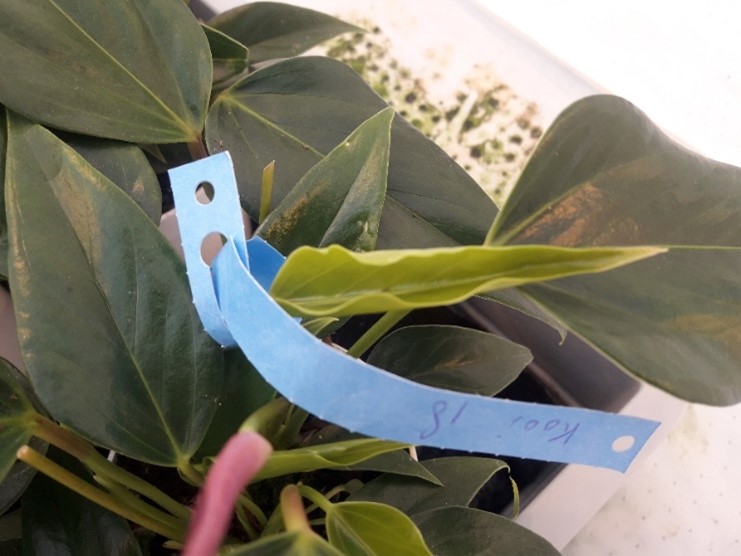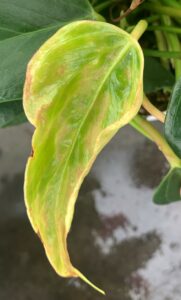Introduction
Tobacco thrips (Thrips parvispinus) are found worldwide and well-known in countries such as Indonesia, India and China. These thrips also pose a serious threat in Kenya (Papaya crop), the USA and Hawaii. In Europe (Greece) they have also been present for more than 25 years. In the Netherlands, tobacco thrips first appeared in green plant cultivation in 2019 and were discovered in Anthurium cultivation last year (2021).
These thrips behave differently from other thrips. They cause considerable damage to plants and are difficult to control. Therefore, it is important to be alert for signs of tobacco thrips so that early action can be taken. In this article, we focus on spotting and scouting tobacco thrips. Spring has begun and tobacco thrips are “waking up” again. Intake control, close crop attention, alertness and scouting are the key words for their detection. In a few weeks’ time, this research will be completed and in the April edition of Anthurinfo we will discuss the approach to tobacco thrips.
Behaviour
Tobacco thrips hide away at the bottom of the plant, near the growth point of the crop. They do not spread as quickly as other thrips species. The adult thrips are sometimes visible on the plant, but are usually hidden. If startled, they can quickly scamper away. The larvae are mainly found in the young leaves and secondarily in the flower buds. In spring conditions (around 23 ºC day and night) the life cycle of tobacco thrips is very short, lasting around 15 days.
Most Dutch growers found tobacco thrips in the autumn, but during the winter the numbers on the sticky traps decreased significantly and much less crop damage was detected. It is suspected that thrips mainly go into a kind of hibernation in order to rapidly increase their number again in spring, causing serious damage. Thrips can reappear in their old locations after being invisible for three to four months.
We have found that tobacco thrips can become active after transportation or a crop treatment of the plants. Therefore, it is important to adjust controls to coincide with plant movements. It has also become clear that tobacco thrips are returning to areas where there was an infected batch of plants in the previous cultivation round. In pot Anthurium, the differences in susceptibility between varieties to these thrips are well-known. It is preferable to grow sensitive varieties in one section, so that quicker action can be taken in that section when conditions change.
Recognition
The female tobacco thrips can be identified by its pointed black abdomen with a browner front body and head. The male is much smaller, more yellowish in colour and, like the female, can be recognised by its black wings. Nevertheless, differentiating tobacco thrips from other types of thrips remains a challenge. When in doubt, always have the trips identified. The approach to these thrips differs in important ways from other thrips, such as Western flower thrips or Echinothrips americanus/poinsettia thrips. The approach and method of scouting are clearly different.
- Female tobacco thrips
- Male tobacco thrips
Detection
This starts with an intensive examination of the young leaves at least once a week for evidence of the characteristic damage pattern.
- Damage cause in 7 days.
The detection of tobacco thrips is done by a combination of methods. First, the crop is scouted. Experience shows that crop damage is the first sign of tobacco thrips.
- Damage to young leaves by tobacco thrips, 2/3 weeks old.
- Leaf damage in detail caused by tobacco thrips, 2/3 weeks old.
The damage can be seen by yellowing and suberisation of the young leaves. Also, the tobacco thrips cause characteristic scraping damage to the flower stems. In addition, severe infestations of tobacco thrips significantly inhibit growth. This can be observed, among other things, in a reduction of the flower stem length.
As well as careful crop control, it is also advisable to install a system of sticky traps in the greenhouse and monitor them weekly. Thrips do not easily migrate to a blue sticky trap; pheromone sticky traps are much better at attracting thrips. On pheromone traps, tobacco thrips are visible earlier and in higher numbers.
- Leaf damage caused by tobacco thrips. Started: left 2 weeks ago, middle 3 weeks ago and right 5 weeks ago.
- Leaf damage caused by tobacco thrips in leaves of different ages.
Attention
To control tobacco thrips it is necessary to be on high alert across the entire farm. Clean plant material and good intake controls are fundamental. Incidentally, a thorough intake control is always worthwhile.
Stay alert for signs of damage from tobacco thrips, both in the new plant material and in the rest of the greenhouse. Fortunately, we are witnessing more and more companies taking a serious approach to their crop scouting. Specialised personnel and/or external scouting consultants are doing very valuable work in more and more places. You should also make sure the people responsible for crop operations are alert; involve them and inform them about the symptoms of damage.

PheroThrip 2.0 pheromone
Research
Research is being conducted at several institutions on the behaviour of and proper approach to tobacco thrips.
WUR
In order to develop effective control measures and resilient cultivation systems against this new invasive thrips species, it is essential to understand their behaviour, development and interaction with other species. The WUR research focuses on these aspects.
Vertify
In this study by Anthura in collaboration with Koppert, several biological crop protection methods are being tested against tobacco thrips. Please note that this article is in Dutch.
https://www.koppert.nl/nieuws-pers/2021/onderzoek-naar-pepertrips/
Source: www.koppert.nl
- Tobacco thrips damage in leaf and flower.
- Suberisation of the stalk caused by tobacco thrips.
In a few weeks’ time, this research will be completed and in the April or May edition of Anthurinfo we will discuss the approach to tobacco thrips in greater detail.

















